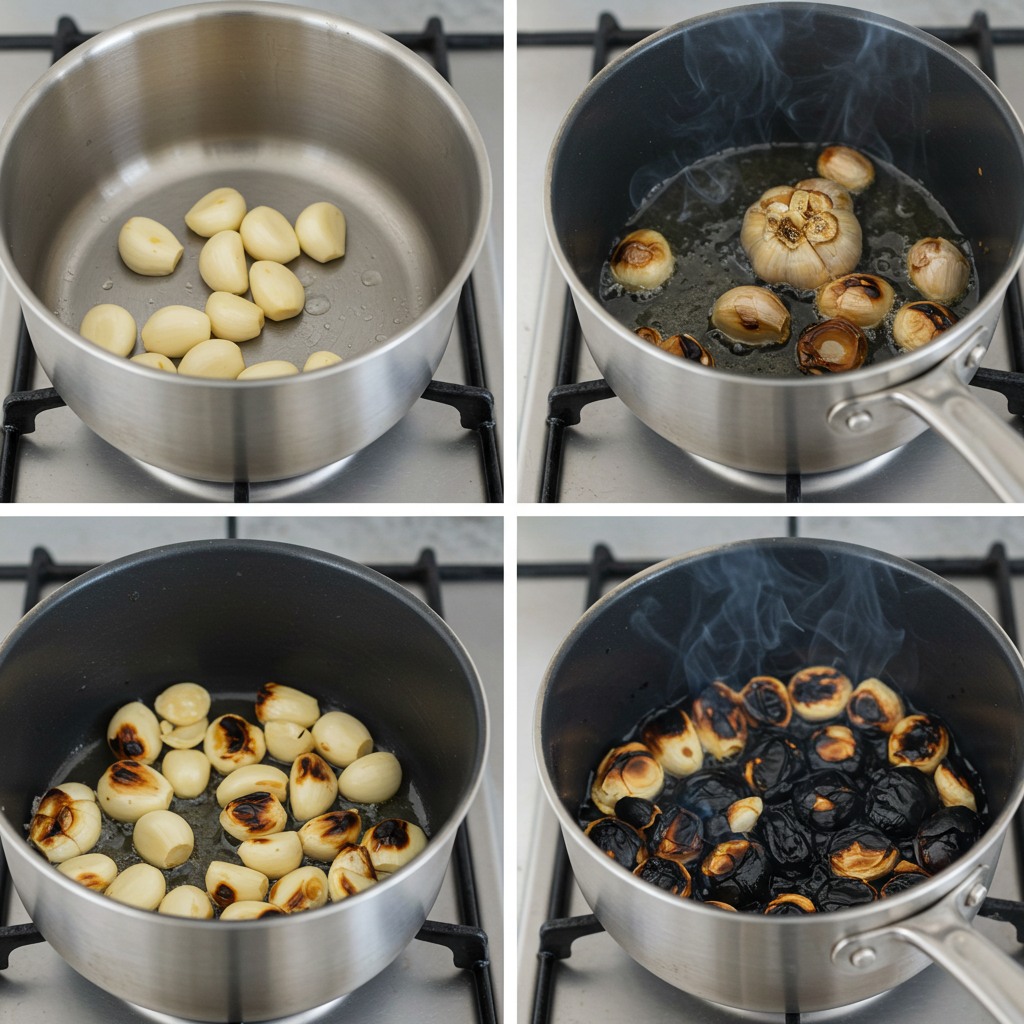ADVERTISEMENT
## **2. What Happens When You Burn Garlic?**
When garlic is burned, several changes occur in both its flavor and chemical composition. Let’s explore the key transformations that happen when you burn garlic at home for approximately 15 minutes.
### **1. Flavor Changes**
Burning garlic changes its flavor profile significantly. Fresh garlic, when chopped or crushed, has a sharp, pungent taste due to the presence of allicin. However, when garlic is heated or roasted, its flavor softens and sweetens. After about 15 minutes of burning, garlic tends to become mildly sweet with a less intense aroma. This happens because the sulfur compounds, which give garlic its pungency, break down during the heating process.
Burnt garlic is often used in culinary dishes for its deeper, more complex flavor. The transformation of garlic from its raw, spicy state to a milder, caramelized one is a process that chefs appreciate, as it adds depth to dishes without overpowering them.
### **2. Breakdown of Allicin**
As mentioned earlier, allicin is the active compound in garlic known for its medicinal properties. When garlic is exposed to high heat for a prolonged period, as it is when burned, allicin begins to break down. After 15 minutes of burning garlic, the allicin is either greatly reduced or completely destroyed. This means that some of the most well-known health benefits of garlic may be lost when burning it for an extended period.
However, it’s important to note that although allicin degrades, other sulfur compounds, such as diallyl disulfide, are formed during the heating process. These compounds can still offer health benefits, though they might not be as potent or specific as allicin in treating certain conditions.
### **3. Release of Other Sulfur Compounds**
Burning garlic causes the formation of other sulfur-based compounds, which contribute to garlic’s flavor, aroma, and health benefits. Some of these compounds include:
– **Diallyl disulfide**: This compound has been shown to have anti-cancer, anti-inflammatory, and antibacterial properties.
– **S-allyl cysteine**: This compound is known to support heart health and reduce cholesterol levels.
– **Ajoene**: Ajoene has antifungal and anticoagulant properties, which make it effective in preventing blood clots and fighting fungal infections.
These compounds are still beneficial, but their properties differ slightly from allicin. Some studies suggest that cooking garlic can enhance the bioavailability of certain compounds, potentially offering different benefits compared to consuming raw garlic.
### **4. Textural Changes**
When garlic is burned, it also undergoes textural changes. Raw garlic is firm and slightly crunchy, but after burning, it softens and becomes almost paste-like in texture. This makes it easier to spread onto bread, mix into sauces, or add to various dishes. Many people appreciate this change in texture, as it allows for a more subtle incorporation of garlic into recipes.
—
## **3. The Health Benefits of Burning Garlic**
Despite the potential loss of allicin when garlic is burned, there are still numerous health benefits associated with consuming burnt garlic. The heat-induced changes to garlic’s chemical composition can still provide therapeutic effects.
### **1. Boosts Immune System**
Garlic is well-known for its ability to enhance immune function. Even when burned, garlic retains many of its immune-boosting properties due to the sulfur compounds that remain after cooking. These compounds help stimulate the production of white blood cells, which are essential for fighting infections.
### **2. Anti-Inflammatory Properties**
Burnt garlic still contains several compounds that possess anti-inflammatory effects. These compounds can help reduce inflammation in the body, potentially benefiting individuals who suffer from chronic conditions such as arthritis, cardiovascular disease, or inflammatory bowel disease (IBD).
### **3. Supports Heart Health**
Garlic, whether raw or burned, has long been linked to heart health. Studies have shown that garlic can help lower blood pressure, reduce cholesterol levels, and improve circulation. Although allicin is the most well-known compound for heart health, sulfur compounds formed during the burning process can also contribute to these effects.
### **4. Antioxidant Effects**
The burning of garlic does not completely destroy its antioxidant properties. Antioxidants are vital for neutralizing harmful free radicals in the body, which can contribute to the aging process and the development of diseases such as cancer. Even after burning, garlic remains a source of powerful antioxidants that protect the body from oxidative stress.
### **5. Digestive Health**
Garlic is beneficial for gut health, and while the allicin in raw garlic is most potent, the sulfur compounds created when burning garlic can also promote healthy digestion. Burnt garlic can support gut flora, relieve bloating, and aid in the breakdown of fats, contributing to improved digestive function.
For Complete Cooking STEPS Please Head On Over To Next Page Or Open button (>) and don’t forget to SHARE with your Facebook friends
